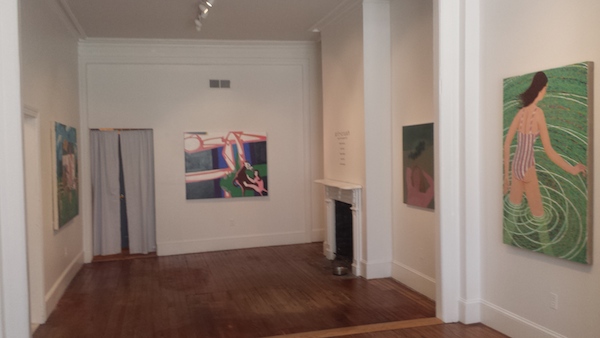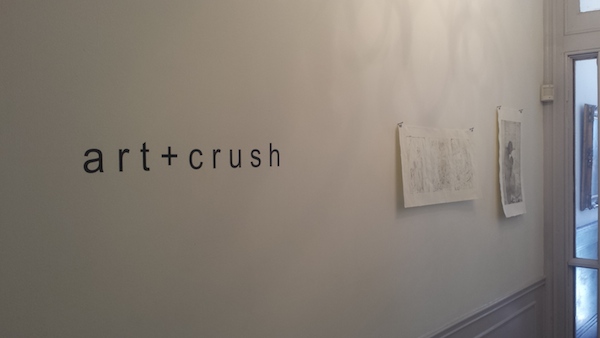Cara Ober interviews Lydia Pettit, Co-Director and Founder of the new Platform Art Center in Baltimore
Platform Gallery was founded in 2014 by Lydia Pettit and Abigail Parrish on the first floor of Platform Arts Center. Functioning as a commercial artist-run gallery, Platform seeks to create thought-provoking shows that question the relationship between artist, curator, and community. Although very new, the gallery plans to provide opportunities for Baltimore and regional artists to show their work.
According to the gallery, “Platform is an open, safe space for artists of all genres to meet and collaborate with community members of any class, race, gender, or age in hopes of influencing future shows and programming. Platform promises to excite audiences beyond the art community, challenge convention, create new paths, and open its doors to change.”
Unlike many art spaces run by young artists, Platform Gallery does not rent their space. Rather, Co-Director Lydia Pettit purchased the building to use in a number of ways, including artist studios and a community center, in addition to the gallery. This multi-use investment, located on the cusp of Baltimore’s Mt. Vernon and Lexington neighborhoods, promises a longevity and seriousness that many new galleries eschew. It also indicates that the new art space can afford to be flexible, take risks, and try out innovative programming, and worry less about sales. Their next exhibit Tell It Slant: Laini Nemett, will be presented in conjunction with ICA Baltimore in September.
Cara Ober: When and why did you open Platform Gallery? Why did you give it this name?
Lydia Pettit: Platform was opened May 31st at the same time as the opening of Platform Arts Center. I opened it with Abigail Parrish because, as I was looking for a building to house affordable studios, I wanted to expand the community aspect and become involved in the arts scene in Baltimore. Abbey and I wanted to provide a space that was versatile and aimed to show works by emerging or unrepresented artists alongside artists that were already established in their careers.
CO: What’s the story with the building as a whole?
LP: The building itself is on the cusp between two neighborhoods with two different populations and backgrounds, and we want our shows to be accessible to anyone who walks into the building. The space is also available to be rented out, currently we have Tango classes and I’m working on connecting with some community organizations to use it as meeting and production spaces, maybe even open mics! The name reflects that, simply a platform for conversation and ideas from all sorts of artists.
CO: What’s your back story in opening a gallery in Baltimore? Are you an artist yourself? When did you graduate from MICA?
LP: I started my search for a large building that could accommodate a number of affordable studios fall 2013, alongside my Senior Thesis at MICA. I decided to embark on the project after, in an effort to find a studio space for myself, finding a gigantic space for rent at 808 Low Street for only 1200 dollars a month.
After deciding it was just a tad bit unsafe as it wasn’t up to code and you could fall through the floor, I wanted to keep running with the idea, so I met up with realtors Rachel Rabinowitz and David Tomasko. They have a mission to work with artists to acquire live/work spaces, or to help with projects like mine.
After going through a few options – a funeral home, the old Baltimore City Police stables, etc. – I found 116 W. Mulberry street, a former law office. As mentioned earlier, the space was in between two different neighborhoods, Mount Vernon and Lexington, and was accessible by all modes of public transport. Its on the same block as the library and has all sorts of affordable food options blocks away. It was a perfect location for a studio building and the building itself felt like a home- it was built in the 1830’s and was originally a residence.
I settled on March 19th, 2014 and worked with my friend’s father, a contractor, to split up the studios with Homasote and to prep the gallery space on the first floor. It was all ready by May 31st when we had our grand opening, shortly after I graduated with a BFA in painting from MICA.
CO: So far Platform Gallery has hosted ‘Starcrossed: The Art of Promotion,’ an exhibit of hand printed posters for music shows, Tradition and Interpretation: Works by Stephen Towns and Jeffrey Kent, and now ‘art+crush’ which features two local artists and two artists who have influenced them. (feel free to add in anything i have missed here) From these early exhibits, can you describe what the gallery’s mission or aesthetic is?
LP: I have been really in love with Baltimore for a while, in all its facets and complexities and flaws. I grew up in Towson so starting an arts building here was a no brainer for me. The arts scene here feels much more like a community than in other places, everyone is extremely supportive and plugged in to the smallest happenings in the smallest galleries and DIY spaces. It’s intimate and nice and is exactly the kind of place I could grow my own community.
One of the best things about MICA was the studio center, where you could just walk out of your space and chat with a friend or acquaintance about anything when you were having difficulty or were just taking a break. I loved working that way with my painting, I could get feedback easily and could look at everyone else’s work to get inspired and excited about what was going on. I wanted to preserve that experience with the building, everything is very open and sometimes tenants come down and help in the gallery when we hang shows. I want everyone to be happy because I need a space to be happy when I make my work, too.
CO: In your opinion, what is the purpose of an art gallery? This seems to be an evolving idea, but in your opinion — What are the responsibilities between an artist and gallery, and the local collecting community and a gallery? The description of your gallery says it is also a ‘community center’ – so does this mean that the gallery is not commercial?
Other than the mission mentioned above, we really like to take each show as an individual entity. We have had a lot of painting and two dimensional works because our space is conducive to that sort of media, but we certainly aren’t opposed to other mediums. We have a few shows coming up proposed by other artists and organizations like ICA, which we are really excited about because it touches on our love for collaboration. It also presents learning opportunities for us, as we are in a state of “learning-as-we-go” with all of this.
We hit the ground running and sprouted our first three shows from three ideas, and everything developed from there. First, we wanted our inaugural show to be works by artists from Baltimore, to cement our connection to our location. Second, we wanted to do a show with Globe Letterpress as Abbey had worked with them during Workin’ the Tease last Spring.
And finally, a r t + c r u s h started with my own art crush on Louis Fratino’s work. He had a studio next to mine at MICA and I was struck by his honesty and frankness in his works about his personal life and relationships. He also can really fucking paint. So from my crush, we found his crush, Xinyi Cheng, who graduated with an MFA from the Mount Royal School of Art in 2014. They both loved each other’s work, even traded it, and decided the show would be about the affinity admiration experienced by artists in response to works they love. Ben Degen and David Humphrey came into the picture when we asked both Louis and Xinyi who was someone whos work they loved, who was at a more advanced stage of their career. Louis loved Ben, Xinyi loved David. And when we showed the older artists the younger’s work, they loved theirs too.
Our following exhibitions for the fall, starting with Tell It Slant: Laini Nemett presented by ICA, take the same route, accessible collections of art curated by ourselves or other artists. We’re flexible, we’re running with it, and we’re learning so much in the process.
The community center comes from the fact that the building as a whole is a collection of artists making work and two women curating as art on the first floor. It also comes from the fact that the gallery space is open to be utilized by all sorts of organizations, and we are hoping to provide programming to the community as well. I believe that there are multiple forms that a gallery can take- whether it is a raw, cycling display of works that could be for sale or not, or a completely for-profit institution.
A gallery to me though, and what I hope Platform will take, is an entity that supports artists and art as a whole. We want the space to be welcoming to people of all sorts, not just artists, to come and enjoy the work. There is an exclusive cold front in some areas of art and we don’t want to replicate that notion, that you have to be or look a certain way in order to enjoy artwork. We also communicate with the artists we show as much as possible to make sure that things are presented in a way that they agree with. I’ve beckoned people off the street through the big bay window, and that is one of my favorite occurrences so far: when a random person walks in and enjoys the work.
We do take commission, but profit is not our goal. We only need enough to provide the essentials for openings and to keep us from going negative, and with shows like our July show we can’t make money. We don’t pay rent because I own the building and the studios cover the cost, so that’s a weight lifted off our shoulders. We are delighted if we can help an artist sell their work though.
Galleries are slates and platforms for artwork and artists, and we want to connect the public to what’s going on in Baltimore and the art world at large.
More info:
Lydia Pettit and Abigail Parrish, Co-Directors
Platform Gallery
116 West Mulberry Street
Baltimore, MD 21201
Open Thursday – Sunday 11-5pm
http://www.platformbaltimore.com









